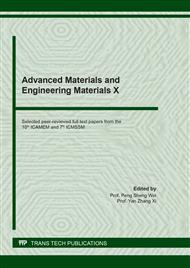p.196
p.202
p.207
p.213
p.221
p.226
p.232
p.237
p.243
Effect of Rice Flour Types on the Properties of Nonwoven Pineapple Leaf Fiber and Thermoplastic Rice Starch Composites
Abstract:
Thermoplastic starches and a nonwoven pineapple leaf sheet (NPALF) were prepared. Two types of flours were used to prepare thermoplastic starches (TPSs) which were Rice flour thermoplastic starch (RTPS) and Glutinous rice flour thermoplastic starch (GTPS). Two layers of thermoplastic starches and NPALF layer were sandwiched and pressed by a hot pressing machine at 150°C with 1500 psi for 15 min. All composites were investigated their densities and tensile properties. The density of all composite types had a lower density than each neat TPSs and types of rice flours did not affect their densities. The tensile property results confirmed NPALF could be used as a reinforcing agent both in GTPS and RTPS composites but their tensile improvement effectiveness in both systems are different. NPALF composite with RTPS did not affect the tensile strength but provided a slight improvement in modulus. Remarkably, NPALF composite using GTPS explored the great improvement performance both in strength and modulus which were increased up to 174% and 308% comparing with neat GTPS. SEM micrograph evidence clearly showed good wetting between GTPS and the reinforcement layer in the composite. This is resulting in the NPALF-GTPS composite showed a strong improvement in tensile properties.
Info:
Periodical:
Pages:
221-225
Citation:
Online since:
November 2021
Authors:
Price:
Сopyright:
© 2021 Trans Tech Publications Ltd. All Rights Reserved
Share:
Citation:


